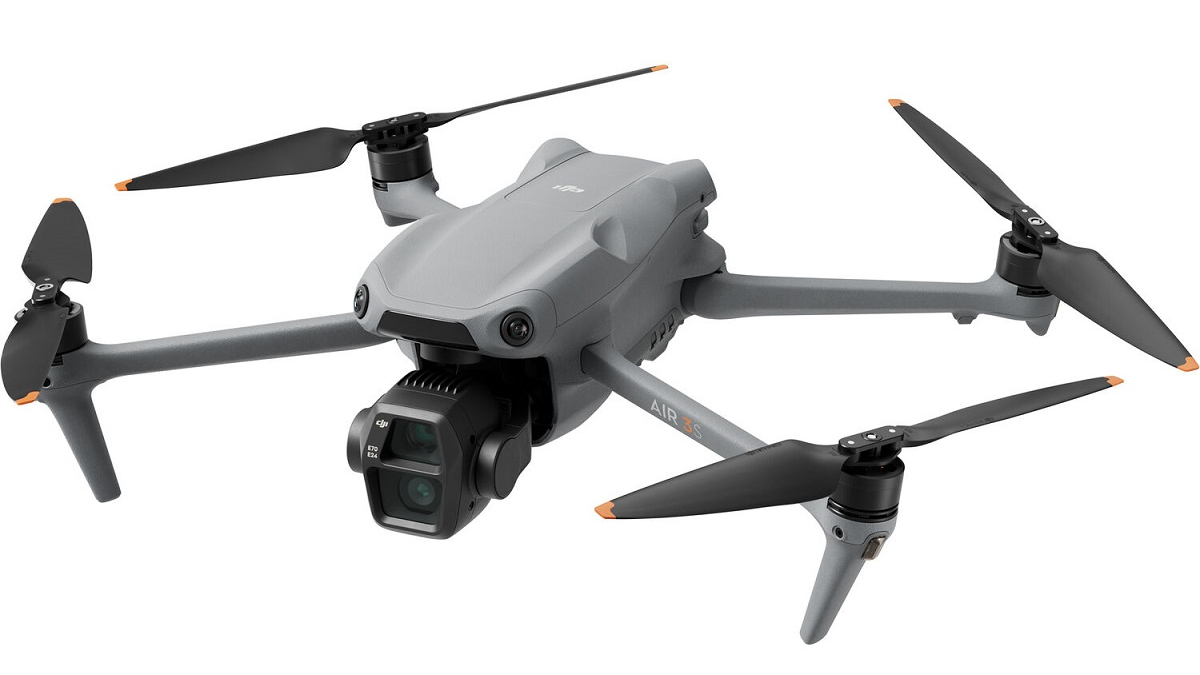
With DJI’s announcement of its new AIR 3S drone, what you see at first glance is an update to DJI’s AIR 3 drone with some primary camera upgrades.
However, the AIR 3S actually delivers a fair bit more than that and includes several interesting new features that as something of a unique consumer UAV. According to DJI itself, the AIR 3S is “perfect for travel photography”.
To start with, the main camera on this new UAV has a beefed-up 50MP Type 1 CMOS sensor behind it with enlarged dimensions of 13.2 x 8.8mm. Overlaying this is the 24mm F1.8 lens of the camera itself.
In comparison, the older Air 3 drone’s sensor measures a lot smaller at 9.6 x 7.2mm with a 48MP resolution and is overlaid by a camera lens with an f/1.7 aperture.
The new AIR 3S does however have the same telephoto camera as its predecessor. This has a 48MP Type 1/1.3 sensor and a 70mm equivalent f/2.8 optic.
As for its recording specs, the upcoming AIR 3S drone is similar to the AIR 3 with a maximum video performance of 4K resolution at 120fps or 4K resolution of 60fps is shooting in HDR. It also captures all of its video in 10-bit color and is capable of D-Log M and HLG modes too.
DJI also claims that both of the 3S’s cameras are capable of 14 stops of dynamic range and exceptional detail thanks to this and other recording specs.
DJI has increased ISO for the AIR 3S too, giving it a maximum of 12,800, which drops to 3,200 if you decide to shoot in D-Log M.
For the 3S’s main camera, DJI claims that it’s designed to deliver “breathtaking detail for travel photography”.
The company adds,
“This large sensor, enhanced by advanced image-processing technology and intelligent algorithms, preserves even minute details in low-light conditions such as sunsets and nightscapes, delivering shots that are simply, effortlessly breathtaking.”
Aside from this, the company has also added what it calls a new, more advanced video encoding algorithm for the AIR S3. According to DJI, this lets the drone’s media files compress by more than 30% with no reduction in visual quality.
Moving on to a range of especially interesting features in the DJI 3S, we start with the drone’s forward-facing LiDAR, which is a complete first for a DJI drone.
For this, DJI specifies,
“..as the first DJI drone to feature forward-facing LiDAR, Air 3S also features a downward infrared time-of-flight (ToF) sensor and six vision sensors (two at the front, rear, and bottom) to achieve nightscape omnidirectional obstacle sensing. [2] This feature enables the drone to automatically identify and circumvent obstacles, such as buildings, during its flight and return paths, ensuring robust safety for nighttime photography.”
A very useful aspect of this new obstacle avoidance technology in the drone is that it lets it combine with the drone’s return-to-home feature to come back to its original takeoff point even in complete darkness.
Another part of its internal flight safety technology is a real-time vision positioning and mapping system that lets the drone memorize its flight path for a safe return in lit conditions even if it has no access to satellite coverage for using GPS.
What’s more, the 3S includes DJI’s ActiveTrack 360 subject tracking with a new focusing ability that lets the drone keep subjects clearly in focus even if they move from center or if you’re flying the drone manually.
Then there’s the 3S drone’s Free Panorama mode. This lets you stitch multiple shots together from a manually chosen subject area for broad, crisp panoramic shots. According to DJI, this feature works best with the telephoto camera, though it’s possible with both cameras.
One other new feature of the DJI 3S is particularly interesting in light of ongoing work by the U.S. federal government to ban the brand’s drones for sale in the United States.
These efforts stem largely due to political concerns about the remote collection of drone-captured data and visuals by the government of China, DJI’s home country.
Likely because of this, DJI has added a new Local Data mode, specifically designed to completely isolate the 3S UAV from any internet connectivity, letting any data captured by users with the drone stay entirely on the device until they allow it to be moved.
DJI describes this feature as being similar to airplane mode on a phone. Regardless of how valid (or not) claims by politicians and others are about DJI remotely collecting data for the benefit of the Chinese government, this mode is quite useful for all kinds of general privacy needs.
DJI’s new AIR 3S really does seem to deliver a pile of features that make it an excellent device for aerial travel photography and video.
Its maximum flight time of 45 minutes, maximum hover time of 41 minutes, flight range of 32 km and maximum flight speed of 21 meters per second are all also useful for robust outdoor performance.
The drone can also transmit 10-bit video at a resolution of up to 1080p/60p with DJI’s O4 transmission tech. Internally, it includes 42GB of storage. The AIR 3S is also pretty light for its size, with a weight of 724g or 1.6lbs
DJI has made the AIR 3S available for preorder at a base price of $1099, which gives you the drone and an RC-N3 controller without its own built-in monitor.
If you want the drone’s more robust Fly More combo pack, it will cost $1,599. However, it includes DJI’s RC 2 controller with its own 700-nit 5.5” 1080p display, an ND filter set, three batteries in total, a charging hub and a shoulder pack.
It’s worth noting that this price is only $49 more than the cost of the same combo for the older AIR 3, which lacks many of the AIR 3S drone’s features.
Images credit: DJI
Credit : Source Post








